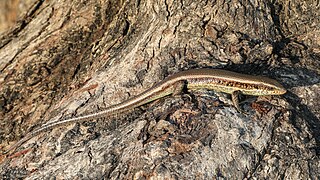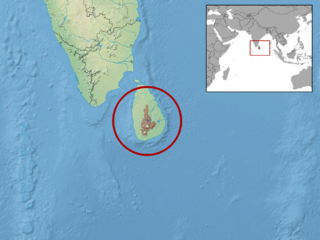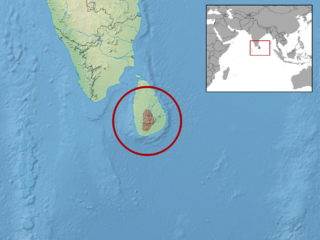
Skinks are lizards belonging to the family Scincidae, a family in the infraorder Scincomorpha. With more than 1,500 described species across 100 different taxonomic genera, the family Scincidae is one of the most diverse families of lizards. Skinks are characterized by their smaller legs in comparison to typical lizards and are found in different habitats except arctic and subarctic regions.

The earless skinks form the genus Hemiergis in the skink family Scincidae. All earless skinks are native to Australia. They are also called mulch skinks.
The Haly's tree skink is a species of lizard in the family Scincidae. The species is native to Sri Lanka. Earlier thought to be found also in the Western Ghats, taxonomic studies have shown D. haliana to be a Sri Lankan endemic, differentiated from the Indian D. subcaeruleum. D. haliana is the only arboreal skink in Sri Lanka.

Eutropis bibronii, also known commonly as Bibron's mabuya, Bibron's skink, and the seashore skink, is a species of lizard in the family Scincidae. The species is native to India and Sri Lanka.

Eutropis carinata, commonly known as the keeled Indian mabuya, many-keeled grass skink or (ambiguously) "golden skink", is a species of skink found in South Asia.
Eutropis dawsoni, also known commonly as Gans's grass skink and Gans's mabuya, is a species of lizard in the family Scincidae. The species is endemic to the southern Western Ghats, India.

The bronze grass skink, bronze mabuya or speckled forest skink, is a species of skink found in South and Southeast Asia. It is a common, but shy, ground-dwelling species that is active both day and night.

Eutropis tytleri is a species of skink, a lizard in the family Scincidae. The species is endemic to the Andaman Islands, India.

Eutropis is a genus of skinks belonging to the subfamily Mabuyinae. For long, this genus was included in the "wastebin taxon" Mabuya; it contains the Asian mabuyas. They often share their habitat with the related common skinks (Sphenomorphus), but they do not compete significantly as their ecological niches differ. This genus also contains the only member of the subfamily to occur in Australasia, the many-lined sun skink, whose wide range includes New Guinea.

Eulamprus quoyii, more commonly known as the eastern water skink, eastern water-skink, or golden water skink, is a viviparous species of diurnal skink. Eulamprus quoyii belongs to the family Scincidae and is considered a common garden animal in Australia. The skink is endemic to Australia and found only along the east coast of the country. It makes its home in creekside habitats along the east coast of Australia and in urban garden areas with high amounts of moisture. The species can be identified by the twin, long yellow stripes that run along its body from the top of the eye, as well as by several more specific character derived states. The pale yellow dorsolateral stripes are most likely where its common name, the golden water skink, is derived. Like other ectotherms, the skink can often be seen basking in the sun on rocky outcroppings in order to regulate its body temperature. Its diet mainly consists of both aquatic and terrestrial insects, tadpoles and small amounts of plant matter. The skink both hunts for food and scavenges when necessary and is considered an opportunistic feeder. It is prey to larger lizards, snakes, cats and birds and so will often be seen moving quickly into hiding when other organisms are present.

Lankascincus deignani, commonly known as Deignan's tree skink and the Deignan tree skink, is a species of lizard in the family Scincidae. The species is endemic to the island of Sri Lanka.

Lankascincus taprobanensis, also known commonly as the Ceylon tree skink and the smooth Lanka skink, is a species of lizard in the family Scincidae. The species is endemic to the island of Sri Lanka.
Lankascincus dorsicatenatus, also known as the catenated lankaskink, is a species of skink, a lizard in the family Scincidae. The species is endemic to island of Sri Lanka.
Eutropis floweri, also known commonly as Flower's skink, Taylor's skink and Taylor's striped mabuya, is a species of lizard in the family Scincidae. The species is endemic to the island of Sri Lanka. It is probably named after Stanley Smyth Flower.
Eutropis madaraszi, also known commonly as the Sri Lanka bronze mabuya, the Sri Lanka bronze skink, or (ambiguously) the spotted skink, is a species of lizard in the family Scincidae. The species is endemic to the island of Sri Lanka.
Eutropis austini is a species of skink, a lizard in the family Scincidae. The species is endemic to Sri Lanka.
Eutropis greeri is a species of skink, a lizard in the family Scincidae. The species is endemic to Sri Lanka.

Ctenotus leonhardii, known by the common names Leonhardi's ctenotus, Leonhardi's skink, and the common desert ctenotus, is a species of lizard in the subfamily Sphenomorphinae of the family Scincidae. The species is found in a range of arid and semi-arid regions throughout mainland Australia. Named after German anthropologist Moritz von Leonhardi in 1919, it belongs to the genus Ctenotus, one of the largest genera of lizards in Australia.

Plestiodon japonicus is a species of lizard which is endemic to Japan. The IUCN lists the species as least concern.












